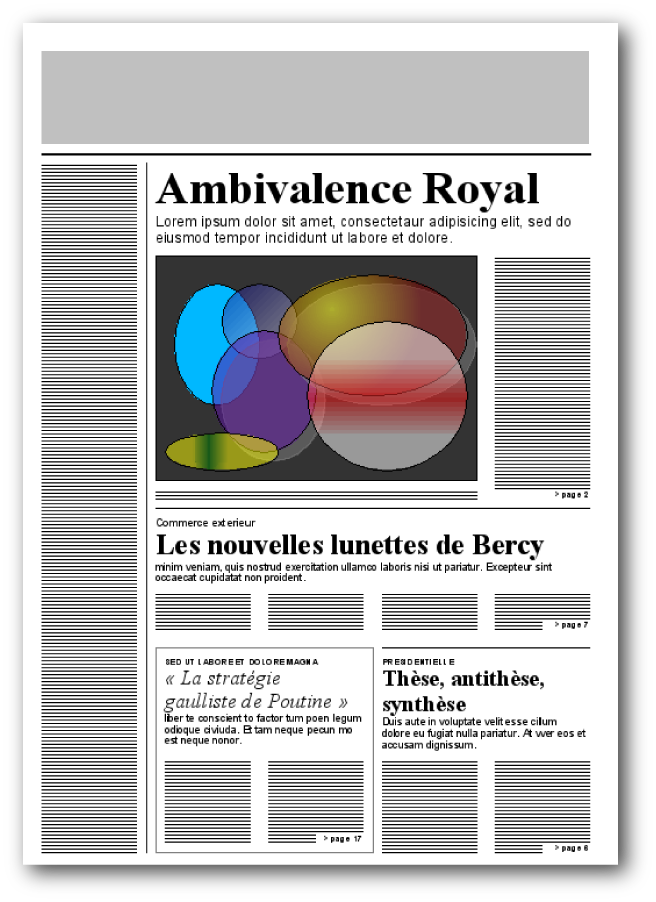A new life for old standards?
▸ ▸ ▸ ▸ ▸ ▸ ▸ ▸ ▸ ▸ ▸ ▸ ▸ ▸ ▸ ▸
Revisions to HTML, CSS and others

Web Directions South, Sydney
September 27, 2007
▸ ▸ ▸ ▸ ▸ ▸ ▸ ▸ ▸ ▸ ▸ ▸ ▸ ▸ ▸ ▸
To view: switch to full screen
With Javascript: Press A


▸ ▸ ▸ ▸ ▸ ▸ ▸ ▸ ▸ ▸ ▸ ▸ ▸ ▸ ▸ ▸
Common theme:
Modify technology or replace it?
ToC:
▸ ▸ ▸ ▸ ▸ ▸ ▸ ▸ ▸ ▸ ▸ ▸ ▸ ▸ ▸ ▸
See WAF WG's Note
[Pity, HTML and XForms aren't ideal :-( ]
That seems to confirm the hypotheses that people (who? implementers? or users?) prefer to struggle along with old HTML rather than take the (small) hurdle of defining a new format that would make describing interfaces easier.
▸ ▸ ▸ ▸ ▸ ▸ ▸ ▸ ▸ ▸ ▸ ▸ ▸ ▸ ▸ ▸
→ XHTML 1.0, 1.1, 2.0
Workshop Future of HTML, 1998:
Must focus on XHTML
→ HTML5
Majority opinion in 2007:
Must focus on HTML
Pro: HTML is popular and still extensible
Con: new features limited by old bugs
Seems another case of rather struggling along than learning something new. But I'll leave the real analysis to Chris Wilson, who no doubt will have something to say about that in his talk after this one.
▸ ▸ ▸ ▸ ▸ ▸ ▸ ▸ ▸ ▸ ▸ ▸ ▸ ▸ ▸ ▸
Also chartered to create a new combined format
(not yet made)
CDF is not a case either for or against the hypothesis. Defining a minimum set of things that HTML can be combined with is a very old idea. And CDF is still planning to create a new format (although it will be a format made by combining XHTML and SVG elements into one language).
▸ ▸ ▸ ▸ ▸ ▸ ▸ ▸ ▸ ▸ ▸ ▸ ▸ ▸ ▸ ▸
For closed captioning, news tickers, film credits, etc.
Multimedia people are not afraid of new tools!
These are new. So in the multimedia area at least people still believe in creating someting new.
▸ ▸ ▸ ▸ ▸ ▸ ▸ ▸ ▸ ▸ ▸ ▸ ▸ ▸ ▸ ▸
 New level 2 better specified than the old
New level 2 better specified than the old
But no new features
New features are being developed and implemented
(as level 3)
We want your opinion
Is it time to replace CSS?
If not, what needs adding?
Back in 1994, when Håkon and I started work on CSS, I expected HTML to last 50 years or more, but also expected CSS to not last longer than 10 years. I may still be right about HTML, but I severely underestimated CSS's potential. Still, we designed it to be extensible (more than HTML and XML) and 10 years after the first Recommendation, it still is extensible.
Although CSS has some parts that turned out less elegant than hoped (absolute positioning, in particular), and there are many bug in implementations, it seems those bugs and the existing features are not a hindrance to adding new features.
The question is more which of the many requested features to start with!
▸ ▸ ▸ ▸ ▸ ▸ ▸ ▸ ▸ ▸ ▸ ▸ ▸ ▸ ▸ ▸
A sample of designer's demands.
▸ ▸ ▸ ▸ ▸ ▸ ▸ ▸ ▸ ▸ ▸ ▸ ▸ ▸ ▸ ▸
Priorities depend on:
 What is technically possible
What is technically possible
Designers' wishes
▸ ▸ ▸ ▸ ▸ ▸ ▸ ▸ ▸ ▸ ▸ ▸ ▸ ▸ ▸ ▸


There are two slightly different different ways to define the grid, depending on your point of view. In the second example, you can either say there are three columns and the text has some padding; or you can say there are five columns and two of them are empty.
CSS will probably allow both views.
▸ ▸ ▸ ▸ ▸ ▸ ▸ ▸ ▸ ▸ ▸ ▸ ▸ ▸ ▸ ▸
Traditional layout method
display: "a b b c" "d e e f" "d e e f"
Example of a 4×3 page template
Two CSS modules try to adapt the method to the screen
▸ ▸ ▸ ▸ ▸ ▸ ▸ ▸ ▸ ▸ ▸ ▸ ▸ ▸ ▸ ▸
 Almost equal to CSS level 2
Almost equal to CSS level 2
plus “marquee”
Developed with OMA
Final draft was planned for June
(we're a bit late)
There already was a Mobile Profile, a slightly smaller one. In fact, there were two, one by W3C and one by WAP (now OMA). The two were almost the same, but the fact there were two was confusing.
The new profile is the same for OMA and W3C. (Or more precisely, the new CSS Mobile Profile plus the WICD Mobile profile of XHTML together are equivalent to the OMA XHTML and CSS profiles, because some features that W3C put in WICD Mobile, OMA put in the CSS profile.)
One reason we're late is that the marquee properties aren't quite ready yet. They are based on a previous OMA specification, but that specification wasn't very precise and the behavior needed to be tight in with overflow behavior. Plus, marquee has to remain optional for desktop implementations.
▸ ▸ ▸ ▸ ▸ ▸ ▸ ▸ ▸ ▸ ▸ ▸ ▸ ▸ ▸ ▸



▸ ▸ ▸ ▸ ▸ ▸ ▸ ▸ ▸ ▸ ▸ ▸ ▸ ▸ ▸ ▸
Different from vertical text
(which uses different typographical rules)
Arbitrary angles
Rotate blocks before or after layout
(resp., allow rotated block to overlap or not)
Computers seem powerful enough now,
but what is the priority of this features?
▸ ▸ ▸ ▸ ▸ ▸ ▸ ▸ ▸ ▸ ▸ ▸ ▸ ▸ ▸ ▸
http://www.w3.org/Talks/2007/0927-W3C-Sydney
Copyright © 2007 World Wide Web Consortium, (Massachusetts Institute of Technology, European Research Consortium for Informatics and Mathematics, Keio University). All Rights Reserved. http://www.w3.org/Consortium/Legal/2002/copyright-documents-20021231

Three parts and a common theme. The three parts: a small sample of work of W3C, a little more about CSS, and feedback from the audience on what W3C should work on next, especially in CSS.
The common theme: modify existing technology until it can't be modified any longer (until it breaks?), or design something better? W3C has responsability to think about the long term, but user demands are often short-term. And “user” in this case are not just end users, Web designers and Web developers, but also Web software developers.